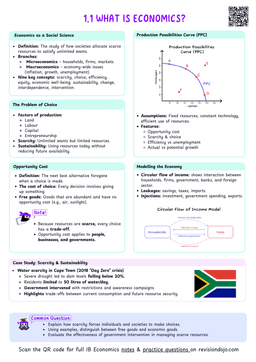- GDP and GNI statistics are widely used to measure economic activity.
- However, they may not always be appropriate to:
- Measure economic well-being.
- Make comparisons over time.
- Make comparisons between countries.
GDP/GNI do not measure economic well-being
Economic well-being
The level of prosperity, economic satisfaction, and standard of living experienced by members of an economy.
While greater GDP/GNI may be correlated to greater economic well-being, this is not always the case. This is because:
- GDP/GNI do not measure the composition of an economy's output.
- GDP/GNI do not distinguish between merit and demerit goods, these national income statistics only focus on the final value of the output.
- Therefore, an economy producing education and libraries (merit goods) may have lower GDP than an economy producing military weapons (demerit goods).
- GDP/GNI do not measure improvements in education, health, and life expectancy.
- GDP/GNI do not measure the distribution of the output/income across the population:
- An economy where all output or income is owned by a single individual may have the same GDP or GNI per capita as an economy where income is evenly distributed among the population..
GDP growth not reflecting improvements in economic well-being: Saudi Arabia
Where: Saudi Arabia
When: Ongoing (since the discovery of oil in the 20th century)
What: Saudi Arabia has one of the highest GDPs in the Middle East, driven primarily by oil production and exports, which make up a significant portion of its output.
Why: The reliance on oil production creates a high GDP, but this does not fully reflect the well-being of the population. Despite its wealth, Saudi Arabia has faced challenges related to income inequality, reliance on non-renewable resources, and limited investment in sectors like education and healthcare (historically).
How: Saudi Arabia's economy remains heavily dependent on oil revenues, meaning much of the wealth is concentrated in a few hands or specific industries, while economic diversification is still a work in progress.
So?: The high GDP of Saudi Arabia does not necessarily translate to improved economic well-being for all citizens. It illustrates how GDP fails to measure the composition of output, improvements in health or education, or the distribution of income. For example, investments in oil infrastructure inflate GDP, but this doesn't guarantee better life expectancy or equitable income distribution. This example highlights how GDP can misrepresent broader measures of societal progress and well-being.
GDP/GNI are not always accurate in making comparisons over time
Using per capita values
- Population size changes over time.
- Using per capita values allows to account for the population growth.
- This yields accurate measures of economic growth in an economy.
GDP growth and GDP growth per capita: Singapore
Who/Where: Singapore
When: 1960s to present
What: Singapore’s GDP per capita has grown significantly due to rapid industrialization, trade openness, and investment in education and infrastructure.
Why: Despite being a small island nation with limited natural resources, Singapore maintained a stable population size while achieving consistent GDP growth. As a result, GDP per capita surged from around \$500 in the 1960s to over \$70,000 in 2023. This reflects not only economic expansion but also rising individual living standards.
So?: Demonstrates how focusing on GDP per capita provides a clearer measure of economic growth and improvements in quality of life. Unlike countries with high population growth, Singapore’s consistent rise in GDP per capita aligns closely with its enhanced economic prosperity and standard of living.
GDP growth without GDP growth per capita: India
Who/Where: India
When: 2000s to present
What: India’s GDP has grown significantly due to economic reforms, technological advancement, and global trade. However, its rapidly growing population has impacted GDP per capita.
Why: While the economy expanded, the population surged from around 1 billion in 2000 to over 1.4 billion in 2023. This high population growth diluted the impact of GDP growth on individual living standards, slowing the increase in GDP per capita.
So?: Highlights that while GDP shows strong economic expansion, GDP per capita provides a more accurate picture of individual prosperity. India's case underscores the importance of adjusting for population size when comparing economic progress over time or across countries.


